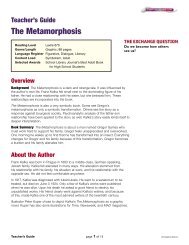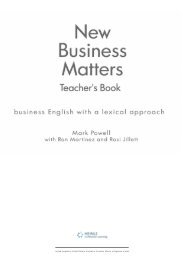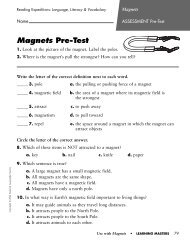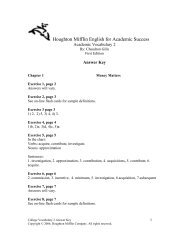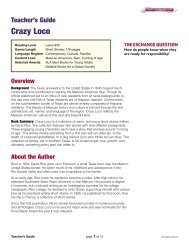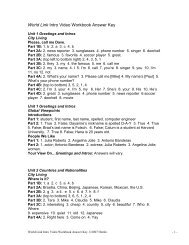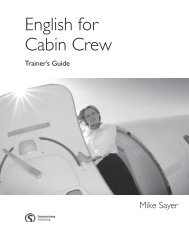Top 20, Great Grammar for Great Writing, First Edition Teaching Notes
Top 20, Great Grammar for Great Writing, First Edition Teaching Notes
Top 20, Great Grammar for Great Writing, First Edition Teaching Notes
Create successful ePaper yourself
Turn your PDF publications into a flip-book with our unique Google optimized e-Paper software.
sentences on the cards. Ask them to then indicate additional parts of speech to be added(subject, verb, adjective, etc.) and exchange cards with a classmate, who will expand theoriginal sentence. Have students share their sentences with the group. Alternatively,write words on index cards or slips of paper and have students rearrange the cards tomake simple, compound, or complex sentences.Sentence Variety (14.2)Students often use the same sentence structures throughout their writing and need extrapractice varying the structure and length of their sentences. This section gives thempractice varying the types of sentences they use through combining elements, usingmodified appositives, combining or expanding sentences, varying the beginnings ofsentences, and reordering elements of sentences.Vary Sentence Structure and Length (14.2.1)Introduce the section by writing groups of extremely short and/or long sentences on theboard. Ask students to suggest ways to combine and/or shorten the sentences in order toadd variety. Add words or erase them as necessary. Follow with Exercise 3. Havestudents share their answers, emphasizing that there may be more than one way to rewritea sentence.Exercise 4 requires students rewrite sentences and then put them in order to <strong>for</strong>m aparagraph. To highlight how varying the structure and length results in a moreinteresting paragraph, put the original unedited sentences, in paragraph <strong>for</strong>m, side-by-sidewith the paragraph of the edited sentences.Sentence Beginnings (14.2.2)Index cards are useful <strong>for</strong> introducing the concept of varying sentence beginnings. Writesentences elements on cards, grouping those which must stay together. For example,write following grouped words on cards: (The students) (quickly) (scrambled) (to findtheir seats) (when their professor entered the room). Have students rearrange the cardsto practice varying the beginnings. Have students do the same with the sentences inExercise 5, sharing their answers with a partner or with the class. For a follow-upassignment, ask students to find news articles or books containing sentences whichdemonstrate a variety of sentence beginnings.Vary Subject-Verb Sequence (14.2.3)Introduce this section by reviewing how to shorten or “collapse” compound sentenceswhich have the same subject and or verb: My boss is a new manager from New York, andshe’s trying to implement east coast techniques into our west coast office. My boss, anew manager from New York, is trying to implement east coast techniques into our westcoast office. Have students work in pairs to complete Exercise 6. Have students sharetheir answers to emphasize that there is more than one way to edit to add variety towriting.Common Sentence Problems and Challenges (14.3)2



